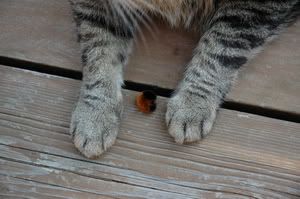You will probably start at a low dose, usually twice a day. The needles are given subcutaneously (under the skin). My first reaction to this notion was that I could never give my cat needles. Well, fear not. They can hardly even feel them. Many vets like the humulin insulins, as they are cheap, easy to get, and work very well for many cats. Unfortunately, Eli Lilly, the maker of two very popular insulins for cats, L and U have discontinued these. Alternatively, your vet may start you on the pork based insulin called Caninsulin in Canada (Vetsulin in the United States). This insulin is exactly like canine insulin and similar to feline insulin. Other insulins that are available are PZI Vet, Lantus (a long lasting human insulin) and a new insulin called Levemir that is showing some promise in cats.

After a week or two, the vet will probably ask you to bring your cat back to do a glucose curve. It will give an indication on how well the insulin is working. Based on this, the vet will decide whether to increase, decrease or maintain the dose. Many people are now testing their cats blood sugar at home using a human glucometer.
Kitty is INCREDIBLY fractious at the vets and there would be absolutely no point in doing a curve at the vets as stress can raise blood sugar levels even higher, throwing the results off. We do glucose curves at home and I will describe later how to do this and what the results may mean.
The final thing that the vet will alert you to is signs of hypoglycemia (low blood sugar). Many cats can get low blood sugar without any symptoms. However, if your cat seems to be acting strangely, disoriented, having seizures or convulsions, it is possible that their blood sugar has gone too low. Always keep some corn syrup around and apply to the cats gums if they won't eat it. This will create an increase in blood sugar, albeit temporary. Feeding some of their regular food afterwards will hopefully pick up where the corn syrup has worn off. This is where being able to test at home is an invaluable tool. If you are uncertain what is going on, please get your cat to the vet as soon as possible.
So, you leave the vet armed with-
a) your cat
b) the insulin and syringes
c) instructions on how to treat hypoglycemia and
d) perhaps a new diet.
It all seems so overwhelming those first few weeks, but I can promise you that it will all start to make sense and get much, much easier!
Feline diabetes is NOT a death sentence.
It takes diligence and care, but your cat can live a long, happy life with it.